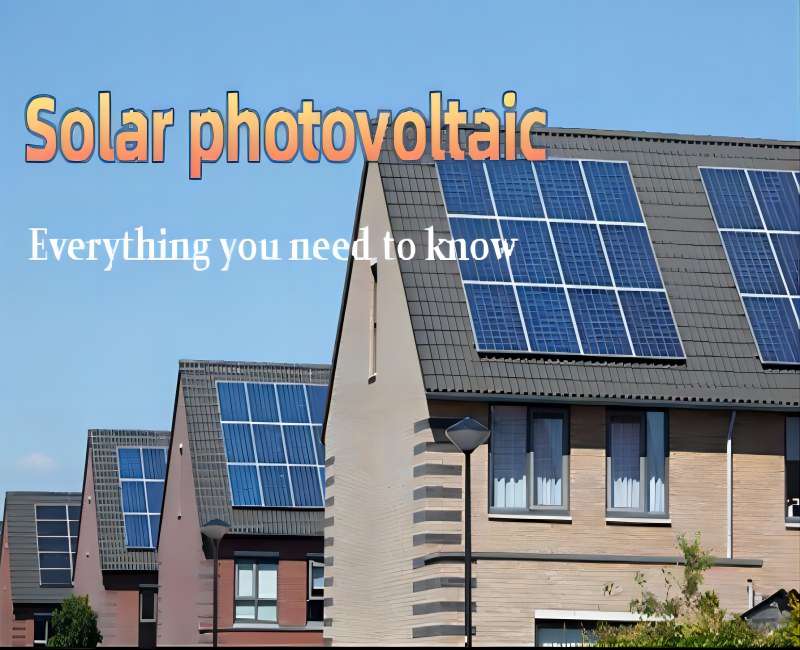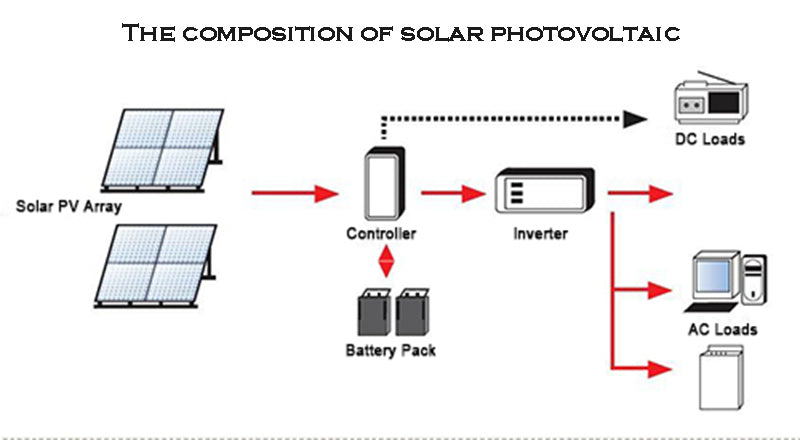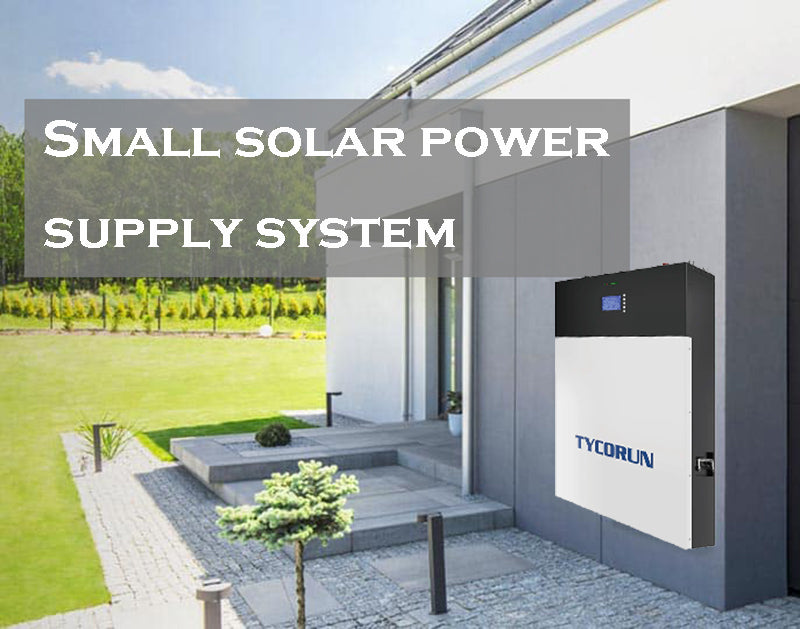
Main content:
Solar photovoltaic power plants are mainly divided into two categories: centralized power plants and distributed power plants. Compared with traditional large-scale wind power plants, solar photovoltaic power plants can not only be installed centrally on a large scale, but can also be distributed in multiple scenarios such as building surfaces and outdoors.
Principle of solar photovoltaic system
The solar photovoltaic system consists of the following three parts: solar battery components, charge and discharge controllers, inverters, test instruments and computer monitoring and other power electronic equipment and batteries or other energy storage and auxiliary power generation equipment.
Solar photovoltaic systems have the following characteristics:
- No rotating parts, no noise;
- No air pollution and no waste water discharge;
- There is no combustion process and no fuel is required;
- Simple maintenance and low maintenance cost;
- The operation reliability and stability are good;
Solar photovoltaic systems are widely used, and the basic forms of solar photovoltaic system applications can be divided into two categories: independent power generation systems and grid-connected power generation systems. The main application areas are mainly in aerospace, communication systems, microwave relay stations, photovoltaic water pumps and household power supply in areas without electricity and power shortages.
With the needs of technological development and sustainable development of the world economy, some countries have begun to promote urban photovoltaic grid-connected power generation in a planned way, mainly to build household rooftop photovoltaic power generation systems and MW-level centralized large-scale grid-connected power generation systems. The application of solar photovoltaic systems has been vigorously promoted in transportation and urban lighting.
The scale and application form of solar photovoltaic systems are different. For example, the scale of the system is very large, ranging from 0.3-2W solar garden lights to MW-level solar photovoltaic power stations, such as 3.75kWp household roof power generation equipment. Its application forms are also various, and it can be widely used in many fields such as household, transportation, communication, and space applications. Although photovoltaic systems vary in size, their composition and working principles are basically the same.

The composition of solar photovoltaic
Photovoltaic module square array: It is composed of solar cell modules (also called photovoltaic cell modules) in series and parallel according to the system requirements. It converts solar energy into electrical energy for output under the illumination of sunlight. It is the core component of the solar photovoltaic system.
Storage battery: store the electrical energy generated by the solar cell components, and release the stored electrical energy to meet the energy demand of the load when the light is insufficient or at night, or when the load demand is greater than the electricity generated by the solar cell components. It is the storage battery of the solar photovoltaic system.
At present, lead-acid batteries are commonly used in solar photovoltaic systems. For systems with higher requirements, deep-discharge valve-regulated sealed lead-acid batteries, deep-discharge liquid-absorbing lead-acid batteries, etc. are usually used.
Controller: It regulates and controls the charging and discharging conditions of the battery, and controls the power output of the solar cell components and the battery to the load according to the power demand of the load. It is the core control part of the entire system. With the development of the solar photovoltaic industry, the functions of the controller are becoming more and more powerful, and there is a tendency to integrate the traditional control part, inverter and monitoring system.

Inverter: In the solar photovoltaic power supply system, if there is an AC load, an inverter device is used to convert the DC power generated by the solar cell module or the DC power released by the battery into the AC power required by the load. The basic working principle of the solar photovoltaic power supply system is to charge the battery with the electric energy generated by the solar cell module through the control of the controller under the irradiation of sunlight, or directly supply power to the load when the load demand is met.
Then, the battery supplies power to the DC load under the control of the controller. For a photovoltaic system containing an AC load, an inverter needs to be added to convert the DC power into an AC power. The application of photovoltaic systems takes many forms, but the basic principles are similar.
Classification and introduction of solar photovoltaic systems
Generally, photovoltaic systems are divided into independent systems, grid-connected systems and hybrid systems. According to the application form, application scale and load type of the photovoltaic system, the photovoltaic power supply system can be divided into the following six types: small solar power supply system, simple DC system, large-scale solar power supply system, AC, DC power supply system, grid-connected system, hybrid power supply system, grid-connected hybrid system.Small solar power supply system
The characteristic of this system is that there is only DC load in the system and the load power is relatively small, the whole system has a simple structure and is easy to operate. Its main use is general household systems, and the load is various civilian DC products and related entertainment equipment.
For example, this type of photovoltaic system has been widely used in remote areas of northwest my country, and the loads are DC energy-saving lamps, tape recorders and TV sets, etc., to solve the basic lighting problems of households in areas without electricity.

Simple DC system
The characteristic of the system is that the system load is a DC load and there is no special requirement for the use time of the load. The load is mainly used during the day, so the system does not use a battery, nor does it need to use a controller. The system has a simple structure, and directly uses the solar cell components to supply power to the load, which saves the loss caused by the storage and release of energy in the battery and the energy loss in the controller, and improves the utilization efficiency of solar energy. It is often used in photovoltaic water pump systems, some temporary equipment during the day, and tourism facilities.Large-scale solar power supply system
Compared with the above two photovoltaic systems, this photovoltaic system is still suitable for the DC power system, but the load power of this solar photovoltaic system is relatively large. In order to ensure a reliable supply of stable power supply to the load, the corresponding system scale is also Larger, larger solar cell module arrays and larger battery packs are required, and are often used in communication, telemetry, monitoring equipment power supplies, rural centralized power supply stations, beacon lighthouses, street lamps and other fields.
The communication base stations built by China Mobile and China Unicom in remote areas without power grids also use this photovoltaic system for power supply.
AC and DC power supply system
This photovoltaic system can provide power for both DC and AC loads at the same time, and has more inverters than the above three systems in terms of system structure, which is used to convert DC power into AC power to meet the needs of AC loads. Usually, the load power consumption of such a system is also relatively large, so the scale of the system is also relatively large. It is used in some communication base stations with both AC and DC loads and other photovoltaic power plants with AC and DC loads.Grid-connected system
The biggest feature of this solar photovoltaic system is that the direct current generated by the photovoltaic array is converted into alternating current that meets the requirements of the mains grid through the grid-connected inverter and then directly connected to the mains network. Outside the load, the excess power is fed back to the grid.

In rainy days or at night, when the photovoltaic array does not generate electricity or the generated electricity cannot meet the load demand, it is powered by the grid. Because the electric energy is directly input into the power grid, the configuration of the battery is omitted, and the process of storing and releasing the battery is saved. However, a dedicated grid-connected inverter is required in the system to ensure that the output power meets the requirements of the grid power for voltage, frequency and other indicators. While in some specific situation, we need off grid solar batteries to make sure the battery can perform normally.
Because of the inverter efficiency problem, there will still be some energy loss. This kind of system can usually use the commercial power and the solar photovoltaic module array in parallel as the power supply of the local AC load, which reduces the load power shortage rate of the whole system. Moreover, the grid-connected PV system can play a role in peak regulation for the public power grid.
However, the grid-connected photovoltaic power supply system, as a decentralized power generation system, will have some adverse effects on the power grid of the traditional centralized power supply system.
Hybrid power supply system
In addition to the solar photovoltaic module array used in this solar photovoltaic system, an oil generator is also used as a backup power source. The purpose of using a hybrid power supply system is to comprehensively utilize the advantages of various power generation technologies and avoid their respective shortcomings.
For example, the advantages of the above-mentioned independent photovoltaic systems are less maintenance, and the disadvantage is that the energy output is weather-dependent and unstable. A hybrid power supply system that uses a combination of diesel generators and photovoltaic arrays can provide weather-independent energy compared to a single-energy stand-alone system.
It is predicted that by 2030, China's photovoltaic power generation capacity needs to reach 9000000000 to 1000000000 kilowatts. By 2060, it will need to reach 3 to 3.5 billion kilowatts. At present, the prospects of home photovoltaics are optimistic about many companies. It is estimated that there are more than 40 million individual roofs in China, for example, 20% of the roofs are covered with solar panels, and the market size of household photovoltaics is 320 billion.
Related article: top 10 photovoltaic battery companies, top 5 distributed photovoltaic companies, solar battery near me